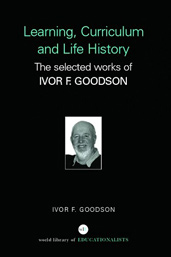Learning, Curriculum and Life Politics: the selected works of Ivor F. Goodson
Representing Teachers
But what is the nature of the turbulence in the intellectual waters surrounding stories, and will they serve to drown the new genre? The turbulence is multifaceted, but here I want to focus on the relationship between stories and the social context in which they are embedded. For stories exist in history – they are, in fact, deeply located in time and space. Stories work differently in different social contexts and historical times – they can be put to work in different ways. Stories then should not only be narrated but also located. This argues that we should move beyond the self-referential individual narration to a wider contextualized, collaborative mode. Again, Carter hints at both the enormous appeal and the underlying worry about narrative and story. At the moment, the appeal is substantial after long years of silencing, but the dangers are more shadowy. I believe that unless those dangers are confronted now, narrative and story may end up silencing, or at least marginalizing in new ways, the very people to whom it appears to give voice.
For many of us, these arguments about the personal, storied nature of teaching and about voice, gender, and power in our professional lives ring very true. We can readily point to instances in which we have felt excluded by researchers’ language or powerless in the face of administrative decrees and evaluation instruments presumably bolstered by scientific evidence. And we have experienced the indignities of gender bias and presumptions. We feel these issues deeply, and opening them to public scrutiny, especially through the literature in our field, is a cause for celebration.
At the same time, we must recognize that this line of argument creates a very serious crisis for our community. One can easily imagine that the analysis summarized here, if pushed ever so slightly forward, leads directly to a rejection of all generalizations about teaching as distortions of teachers’ real stories and as complicity with the power elite, who would make teachers subservient. From this perspective, only the teacher owns her or his story and its meaning. As researchers and teacher educators, we can only serve by getting this message across to the larger society and, perhaps, by helping teachers to come to know their own stories. Seen in this light, much of the activity in which we engage as scholars in teaching becomes illegitimate if not actually harmful (Carter 1993, p. 8).
Carolyn Steedman, in her marvellous work, Landscape for a Good Woman, speaks of this danger. She says, ‘Once a story is told, it ceases to story: it becomes a piece of history, an interpretative device’ (Steedman 1986, p. 143). In this sense, a story ‘works’ when its rationale is comprehended and its historical significance grasped. As Bristow (1991, p. 117) has argued, ‘The more skilled we become at understanding the history involved in these very broadly defined stories, the more able will we be to identify the ideological function of narratives – how they designate a place for us within their structure of telling.’ In reviewing Steedman’s work and its power to understand patriarchy and the dignity of women’s lives, Bristow talks about her unswerving attention to
the ways in which life writing can bring its writers to the point of understanding how their lives have already been narrated – according to a pre-figurative script, Steedman never loses sight of how writers may develop skills to rewrite the life script in which they find themselves (Bristow 1991, p. 114).
